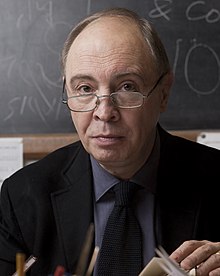Gian Biagio Conte
Gian Biagio Conte (* 1941 in La Spezia ) is an Italian classical philologist and professor of Latin literature at the Scuola Normale Superiore in Pisa.
Life
Conte studied at the Scuola Normale Superiore in Pisa , where he was influenced by scholars such as Antonio La Penna (* 1925), Sebastiano Timpanaro and Alfonso Traina (* 1925). With La Penna, however, after a fruitful collaboration, Conte brusquely broke off all contact in an exchange of letters. Conte also spent long periods of study in Munich with Friedrich Klingner and in Paris. At the age of thirty he became a full professor of Latin literature at the University of Siena , later at the University of Pisa and finally in 2001 at the Scuola Normale Superiore. His high reputation abroad has earned him visiting professorships at Oxford , Cambridge , Princeton , Berkeley and Stanford . In the academic year 1994/1995 Conte Sather was a professor . In 2007 he ran as director of the Scuola Normale Superiore, but was defeated in the elections to the previous director Salvatore Settis , who received his third mandate in a row.
Conte is co-founder and editor of the journal Materiali e discussioni per l'analisi dei testi classici and a full member of the Accademia Nazionale Virgiliana in Mantua . In 2014 he was elected to the British Academy , 2015 to the Academia Europaea .
His students include Alessandro Barchiesi , Alessandro Schiesaro , Rolando Ferri , Sergio Casali .
Services
Conte deals almost exclusively with Latin literature, mainly the poetry of the late republic, the Augustan period and the early imperial period ( Virgil , Lucan , Catullus , the Elegians , Ovid , Lucretius ), but also with prose authors such as Pliny the Elder and the novel of Petron . Conte's approach to Latin literature is characterized by a connection between traditional philology and the innovations of literary theory of the 1970s, particularly structuralism . In his most successful works, for the most part essays that were later compiled in thematic collections, Conte breaks with Croce's historicism and develops the concept of a literary system and literary genre based on corresponding codes . This approach by Contes was just taken up in the Anglo-Saxon philology of the last thirty years and successfully developed in connection with the intertextuality theory . A new Teubneriana from the Aeneid has just appeared ; Conte is currently working, supported by a group of researchers and students, on a commentary on the classical epic, on a commentary on the Satyrica of Petron and on investigations into allegory as a literary and hermeneutic form.
Fonts (selection)
Monographs and collections of articles
-
Memoria dei poeti e sistema letterario. Einaudi, Torino 1974; 2nd edition 1985.
- English translation: The Rhetoric of Imitation. Translated by Glenn W. Most . Cornell University Press, Ithaca / London 1987.
- Virgilio: il genere ei suoi confini. Garzanti, Milano 1984.
-
Letteratura latina: Manuale storico dalle origini alla fine dell'impero romano. Le Monnier, Firenze 1987; 2nd edition 1989; 3rd, expanded edition 1993.
- English translation: Latin Literature: A History. Translated by Joseph B. Solodow, revised by Don Fowler and Glenn W. Most. Johns Hopkins University Press , Baltimore / London 1994 (Peter Davis review: Scholia Reviews ns 5 (1996) 3 ).
-
Generi e Lettori: saggi su Lucrezio, l'elegia d'amore, l'enciclopedia di Plinio. Mondadori, Milano 1991.
- English translation: Genres and Readers. Translated by Glenn W. Most. Johns Hopkins University Press, Baltimore 1994.
-
The hidden author. An interpretation of Petronius' “Satyricon” (= Sather Classical Lectures . Vol. 60). California University Press, Berkeley 1996.
- Italian version: L'Autore nascosto: Un 'interpretazione del Satyricon di Petronio. Il Mulino, Bologna 1997.
- (together with Emilio Pianezzola and Giuliano Ranucci): Il Dizionario della Lingua Latina. Le Monnier, Firenze 2000.
-
Virgilio: l'epica del sentimento. Einaudi, Torino 2002.
- English translation: The Poetry of Pathos: Studies in Virgilian Epic. Edited by Stephen J. Harrison . Oxford University Press, Oxford 2007, ISBN 0-19-928701-5 .
Text-critical edition
- P. Vergilius Maro : Aeneis (= Bibliotheca scriptorum Graecorum et Romanorum Teubneriana . Vol. 2005). De Gruyter, Berlin / New York 2009, ISBN 978-3-11-019607-8 .
Web links
| personal data | |
|---|---|
| SURNAME | Conte, Gian Biagio |
| BRIEF DESCRIPTION | Italian classical philologist |
| DATE OF BIRTH | 1941 |
| PLACE OF BIRTH | La Spezia |
